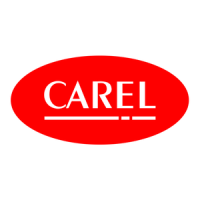Code +030220215- rel. 1.4 – 25.04.2007-
23
As concerns the control parameters, the following general indications can be used as a guide:
Proportional gain (from 3 to 30)
Increasing the proportional gain K increases the reaction speed of the valve and is recommended if the system is
particularly perturbed or to make superheat control faster. If high (>20), may cause swings and instability.
Integration time (from 40 to 400 sec)
Increasing the integration time Ti improves stability but makes the valve slower in reaching the superheat set point.
If lowered (<40 sec) generates swings and instability. If the system is already perturbed, high values (>150 sec) are
suggested so as to avoid creating further disturbance.
Derivative time (from 0 to 10 sec)
Increasing the derivative time Td improves the reactivity of the valve, in particular in perturbed systems, reducing the
amplitude of swings in the superheat. If high (>10 sec), may in turn generate excess reactivity and consequently
swings.
Protector thresholds
The thresholds used for the 4 protectors should be set based on the features of the system being controlled.
All are expressed as temperatures (°C):
LOWER LIMIT
THRESHOLD
UPPER LIMIT
0 °C < LowSH (°C) < Superheat set point
LP pressure switch calibration (°C)
5
< LOP (°C) < design evaporation temperature
design evaporation temperature < MOP (°C) < compressor limit (10-15 °C)
design condensing temperature < HiTcond (°C) < HP pressure switch calibration (°C)
6
Tab. 9.a
5
The pressure switch calibration value, normally expressed as pressure, must be converted to °C (saturated)
control

